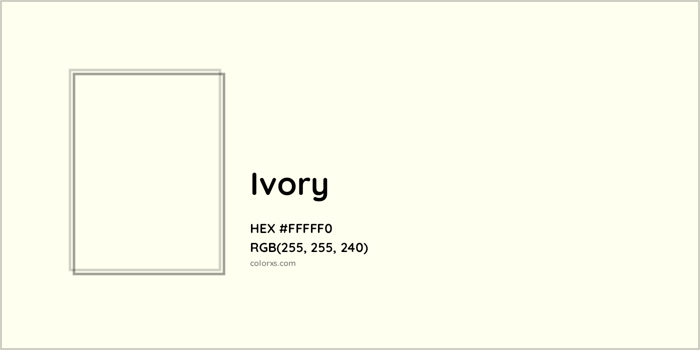The ivory color is a gentle neutral color with beige tones. It is one of the most common base colors for interior design and one of the favorite colors of clothing designers because its simple and neutral hue can easily be matched with any skin tone. This article will cover everything you need to know about ivory color, including its meaning and code, a comparison between ivory color and similar colors, colors that go with ivory color, and common applications of ivory color.
What is Ivory?
Ivory, as the name suggests, is named for the elephant's tusks and has been in use since the 14th century. Ivory color is a pale white color, similar to cream. It usually has a light yellow or pinkish tint. But it is different from pure white color or cream white color. The color ivory is a bit yellow mixed with white, creating a cream shade. Many brides opt for ivory color wedding dresses at weddings rather than pure white in order to add a touch of opulence or communicate a timeless air.
Hex Code of the Color Ivory
The hex color code for Ivory is #FFFFF0. Hex color codes are numbers that specify how much of a color to show on the display. The numbers represent color values ranging from 0 to 255 using specific coding. It can help you quickly distinguish between colors that are similar.
Triadic Color Pallette:

Ivory and Similar Colors
Colors, particularly those that seem as subtle as white and its derivatives, are more intricate than they may initially appear. Ivory, cream, and the various shades of ivory all share a common lineage from white but carry unique undertones and brightness levels that affect how they're perceived and applied.

Ivory vs White
To the untrained eye, white and ivory may appear the same. However, the subtle differences between these two hues significantly impact their application in design and aesthetics. White is a cool-toned color, sometimes considered stark or pure because of its pristine quality. It carries no undertones and is often associated with cleanliness, sterility, and simplicity. White is highly reflective, which contributes to its radiant look.
Ivory, on the other hand, is a slightly off-white hue that leans towards a warm tone. It gets its name from the material ivory, traditionally obtained from the tusks of elephants. Ivory has a subtle yellow undertone, adding a softness to the color that pure white lacks. This slight hint of yellow can sometimes appear as brown or peach in certain lights. In contrast to the cool brightness of white, ivory exudes a warmer, more inviting glow, often associated with elegance and sophistication.
Ivory vs Cream
Cream and ivory are often interchanged, but they bear a few key differences. Cream color is a rich off-white shade that carries a noticeable yellow undertone. It is heavier on the eye than ivory, often giving a sense of warmth and comfort. This color gets its name from the cream, a dairy product with a yellowish hue. In comparison, the yellow undertone of cream is more pronounced than that of ivory, lending cream a richer, fuller, more buttery appearance.
On the other hand, ivory is essentially white with a hint of yellow that's fainter than the cream. The soft subtlety of the ivory color offers a balanced blend between the starkness of pure white and the noticeable yellow undertone of cream. This balance makes ivory a versatile color, able to fit seamlessly in most color palettes, from cool to warm.
Shades of Ivory
Like all colors, ivory comes in various shades, each carrying a slightly different undertone and intensity of color.
Arcadia White
Arcadia White is a shade that resembles ivory, carrying a similar balance of color and brightness. It manages to provide depth to a design without appearing overly yellow or peachy. Its gentle radiance offers a serene and soothing aesthetic, making it ideal for spaces that aim to promote calmness and relaxation.
Ivory White
Ivory White leans more towards white, but still maintains that delicate touch of yellow that defines the ivory family. This subtle warmth makes it compatible with warmer grays, providing a cozy yet modern aesthetic. It's an excellent choice for those looking for a less stark alternative to white but still wanting to maintain a clean, bright ambiance.
Light Ivory
Light Ivory moves towards the yellow end of the spectrum within the ivory family. It's closer to cream than other shades of ivory, featuring a noticeable yellow base that gives it a warm, comforting appeal. Light Ivory works well for people with an ivory skin tone as it complements their natural coloration beautifully. It's a color that's at home in a palette looking for a gentle touch of warmth, without becoming too bold or overwhelming.
Pearl Ivory
Pearl Ivory is a delicate, elegant shade of ivory with a slight sheen, similar to the soft lustre of a pearl. The unique characteristic of this hue is its soft gleam that adds an element of luxury and sophistication. This subdued yet radiant variant of ivory is particularly well-suited for spaces aiming for a touch of opulence without resorting to harsher, more glaring whites.
Antique Ivory
Antique Ivory mimics the color of aged ivory material, possessing a richer, deeper tone. This shade carries a faint brown undertone, adding to its vintage charm. As its name suggests, Antique Ivory is perfect for areas where a classic, timeless aesthetic is desired. Its old-world charm brings a sense of nostalgia and comfort to any space.
Cosmic Ivory
Cosmic Ivory is a lighter and brighter version of traditional ivory. It tends to lean more towards white, with a minimal hint of yellow that's almost unnoticeable. Cosmic Ivory is perfect for those who want to keep the inviting warmth of ivory but also prefer the clean, minimalist appeal of white.
Eco Ivory
Eco Ivory is a variant that embraces a more nature-inspired undertone. It's ivory with a slight hint of green, creating a refreshing and organic visual. This shade of ivory is ideal for spaces that aim to establish a strong connection with nature or convey an eco-friendly aesthetic.
Each of these shades of ivory offers a unique take on the basic hue, providing designers and homeowners alike with a broad spectrum of choices. Whether it's the warm sophistication of Pearl Ivory or the cool freshness of Eco Ivory, the world of ivory hues offers a wealth of options for every aesthetic preference.
Colors That Go With Ivory Color
A variety of color palettes can be combined with Ivory, including:
- Light Gray (#D3D3D3), Slate (#C0C2C9), Ivory
- Lavender (#E6E6FA), Sage (#BCB88A), Ivory
- Copper (#B87333), Teal (#008080), Ivory
- Taupe (#483C32), Tan (#D2B48C), Ivory
Applications of Ivory Color
- Ivory in Interior Design: As a neutral color, ivory can be used well as an interior background and it is sure ivory is a color you can find in most homes.
- Ivory in Clothing: In terms of clothing, ivory is a popular color, especially for wedding dresses. Ivory is a more elegant color that offers the same clean feel as pure white but is warmer, calmer, and more luxurious than white.
- Ivory in Graphic Design: Ivory is also widely used in graphic design, most commonly in wedding invitation design. Ivory symbolizes holiness, elegance, and luxury, and it is perfect to combine with gold to design wedding invitations.
Conclusion
You should now have a greater grasp of ivory color with this post, including its meaning, contrasting color, the graphic design used in Fotor, and more.
FAQs
-
What is the hex code for Ivory color? The hex code for Ivory is #FFFFF0.
-
What are some colors that go well with Ivory? Colors like Light Gray, Slate, Lavender, Sage, Copper, Teal, Taupe, and Tan go well with Ivory.
-
How does Ivory color look like? Ivory color is a pale white color, similar to cream with a light yellow or pinkish tint.
-
What are the applications of Ivory color? Ivory color is commonly used in interior design, clothing, and graphic design.
-
What are the different shades of Ivory? Different shades of Ivory include Arcadia White, Ivory White, and Light Ivory.





